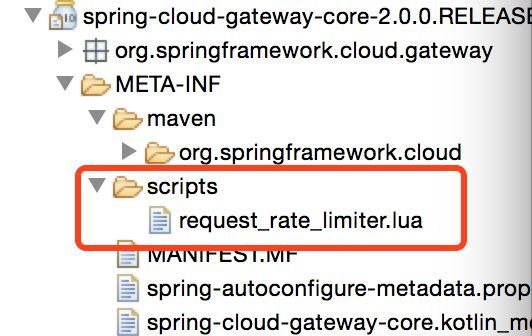您好,登錄后才能下訂單哦!
您好,登錄后才能下訂單哦!
這篇文章主要介紹Spring Cloud Gateway如何實現限流操作,文中介紹的非常詳細,具有一定的參考價值,感興趣的小伙伴們一定要看完!
開發高并發系統時有三把利器用來保護系統:緩存、降級和限流。
API網關作為所有請求的入口,請求量大,我們可以通過對并發訪問的請求進行限速來保護系統的可用性。
常用的限流算法比如有令牌桶算法,漏桶算法,計數器算法等。
在Zuul中我們可以自己去實現限流的功能 (Zuul中如何限流在我的書 《Spring Cloud微服務-全棧技術與案例解析》 中有詳細講解) ,Spring Cloud Gateway的出現本身就是用來替代Zuul的。
要想替代那肯定得有強大的功能,除了性能上的優勢之外,Spring Cloud Gateway還提供了很多新功能,比如今天我們要講的限流操作,使用起來非常簡單,今天我們就來學習在如何在Spring Cloud Gateway中進行限流操作。
目前限流提供了基于Redis的實現,我們需要增加對應的依賴:
<dependency> <groupId>org.springframework.boot</groupId> <artifactId>spring-boot-starter-data-redis-reactive</artifactId> </dependency>
可以通過KeyResolver來指定限流的Key,比如我們需要根據用戶來做限流,IP來做限流等等。
IP限流
@Bean
public KeyResolver ipKeyResolver() {
return exchange -> Mono.just(exchange.getRequest().getRemoteAddress().getHostName());
}通過exchange對象可以獲取到請求信息,這邊用了HostName,如果你想根據用戶來做限流的話這邊可以獲取當前請求的用戶ID或者用戶名就可以了,比如:
用戶限流
使用這種方式限流,請求路徑中必須攜帶userId參數。
@Bean
KeyResolver userKeyResolver() {
return exchange -> Mono.just(exchange.getRequest().getQueryParams().getFirst("userId"));
}接口限流
獲取請求地址的uri作為限流key。
@Bean
KeyResolver apiKeyResolver() {
return exchange -> Mono.just(exchange.getRequest().getPath().value());
}然后配置限流的過濾器信息:
server:
port: 8084
spring:
redis:
host: 127.0.0.1
port: 6379
cloud:
gateway:
routes:
- id: fsh-house
uri: lb://fsh-house
predicates:
- Path=/house/**
filters:
- name: RequestRateLimiter
args:
redis-rate-limiter.replenishRate: 10
redis-rate-limiter.burstCapacity: 20
key-resolver: "#{@ipKeyResolver}"filter名稱必須是RequestRateLimiter
redis-rate-limiter.replenishRate:允許用戶每秒處理多少個請求
redis-rate-limiter.burstCapacity:令牌桶的容量,允許在一秒鐘內完成的最大請求數
key-resolver:使用SpEL按名稱引用bean
可以訪問接口進行測試,這時候Redis中會有對應的數據:
127.0.0.1:6379> keys *
1) "request_rate_limiter.{localhost}.timestamp"
2) "request_rate_limiter.{localhost}.tokens"
大括號中就是我們的限流Key,這邊是IP,本地的就是localhost
timestamp:存儲的是當前時間的秒數,也就是System.currentTimeMillis() / 1000或者Instant.now().getEpochSecond()
tokens:存儲的是當前這秒鐘的對應的可用的令牌數量
Spring Cloud Gateway目前提供的限流還是相對比較簡單的,在實際中我們的限流策略會有很多種情況,比如:
每個接口的限流數量不同,可以通過配置中心動態調整
超過的流量被拒絕后可以返回固定的格式給調用方
對某個服務進行整體限流(這個大家可以思考下用Spring Cloud Gateway如何實現,其實很簡單)
……
當然我們也可以通過重新RedisRateLimiter來實現自己的限流策略,這個我們后面再進行介紹。
限流源碼
// routeId也就是我們的fsh-house,id就是限流的key,也就是localhost。
public Mono<Response> isAllowed(String routeId, String id) {
// 會判斷RedisRateLimiter是否初始化了
if (!this.initialized.get()) {
throw new IllegalStateException("RedisRateLimiter is not initialized");
}
// 獲取routeId對應的限流配置
Config routeConfig = getConfig().getOrDefault(routeId, defaultConfig);
if (routeConfig == null) {
throw new IllegalArgumentException("No Configuration found for route " + routeId);
}
// 允許用戶每秒做多少次請求
int replenishRate = routeConfig.getReplenishRate();
// 令牌桶的容量,允許在一秒鐘內完成的最大請求數
int burstCapacity = routeConfig.getBurstCapacity();
try {
// 限流key的名稱(request_rate_limiter.{localhost}.timestamp,request_rate_limiter.{localhost}.tokens)
List<String> keys = getKeys(id);
// The arguments to the LUA script. time() returns unixtime in seconds.
List<String> scriptArgs = Arrays.asList(replenishRate + "", burstCapacity + "",
Instant.now().getEpochSecond() + "", "1");
// allowed, tokens_left = redis.eval(SCRIPT, keys, args)
// 執行LUA腳本
Flux<List<Long>> flux = this.redisTemplate.execute(this.script, keys, scriptArgs);
// .log("redisratelimiter", Level.FINER);
return flux.onErrorResume(throwable -> Flux.just(Arrays.asList(1L, -1L)))
.reduce(new ArrayList<Long>(), (longs, l) -> {
longs.addAll(l);
return longs;
}) .map(results -> {
boolean allowed = results.get(0) == 1L;
Long tokensLeft = results.get(1);
Response response = new Response(allowed, getHeaders(routeConfig, tokensLeft));
if (log.isDebugEnabled()) {
log.debug("response: " + response);
}
return response;
});
}
catch (Exception e) {
log.error("Error determining if user allowed from redis", e);
}
return Mono.just(new Response(true, getHeaders(routeConfig, -1L)));
}LUA腳本在:

local tokens_key = KEYS[1]
local timestamp_key = KEYS[2]
--redis.log(redis.LOG_WARNING, "tokens_key " .. tokens_key)
local rate = tonumber(ARGV[1])
local capacity = tonumber(ARGV[2])
local now = tonumber(ARGV[3])
local requested = tonumber(ARGV[4])
local fill_time = capacity/rate
local ttl = math.floor(fill_time*2)
--redis.log(redis.LOG_WARNING, "rate " .. ARGV[1])
--redis.log(redis.LOG_WARNING, "capacity " .. ARGV[2])
--redis.log(redis.LOG_WARNING, "now " .. ARGV[3])
--redis.log(redis.LOG_WARNING, "requested " .. ARGV[4])
--redis.log(redis.LOG_WARNING, "filltime " .. fill_time)
--redis.log(redis.LOG_WARNING, "ttl " .. ttl)
local last_tokens = tonumber(redis.call("get", tokens_key))
if last_tokens == nil then
last_tokens = capacity
end
--redis.log(redis.LOG_WARNING, "last_tokens " .. last_tokens)
local last_refreshed = tonumber(redis.call("get", timestamp_key))
if last_refreshed == nil then
last_refreshed = 0
end
--redis.log(redis.LOG_WARNING, "last_refreshed " .. last_refreshed)
local delta = math.max(0, now-last_refreshed)
local filled_tokens = math.min(capacity, last_tokens+(delta*rate))
local allowed = filled_tokens >= requested
local new_tokens = filled_tokens
local allowed_num = 0
if allowed then
new_tokens = filled_tokens - requested
allowed_num = 1
end
--redis.log(redis.LOG_WARNING, "delta " .. delta)
--redis.log(redis.LOG_WARNING, "filled_tokens " .. filled_tokens)
--redis.log(redis.LOG_WARNING, "allowed_num " .. allowed_num)
--redis.log(redis.LOG_WARNING, "new_tokens " .. new_tokens)
redis.call("setex", tokens_key, ttl, new_tokens)
redis.call("setex", timestamp_key, ttl, now)
return { allowed_num, new_tokens }以上是“Spring Cloud Gateway如何實現限流操作”這篇文章的所有內容,感謝各位的閱讀!希望分享的內容對大家有幫助,更多相關知識,歡迎關注億速云行業資訊頻道!
免責聲明:本站發布的內容(圖片、視頻和文字)以原創、轉載和分享為主,文章觀點不代表本網站立場,如果涉及侵權請聯系站長郵箱:is@yisu.com進行舉報,并提供相關證據,一經查實,將立刻刪除涉嫌侵權內容。